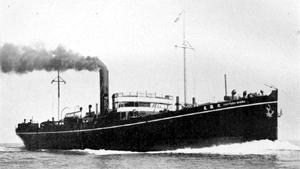RIKUGUN YUSOSEN
 (Sister DAIFUKU MARU)
(Sister DAIFUKU MARU)
NAGATO MARU:
Tabular Record of Movement
© 2013-2014 Bob Hackett
15 October 1917:
Kobe. Laid down at Kawasaki Shipbuilding as Yard No. 409, a
5,901-ton passenger-cargo ship and named DAIFUKU MARU (TAIFUKU) No. 22.
1917:
Sold to the Nippon Yusen Kaisha K. K. (NYK Line), Tokyo. Renamed NAGATO MARU while still on
the stocks.
27 May 1918:
Launched.
27 June 1918:
Completed.
1918-1941:
Serves on NYK’s routes.
November 1920:
NAGATO MARU, in NYK’s cargo service, departs Singapore for Rotterdam, Netherlands and Hamburg, Germany via Colombo, Ceylon (Sri Lanka), Suez and Port Said, Egypt, London and Antwerp, Belgium.
18 October 1941:
Requisitioned by the Imperial Army (IJA). Allotted IJA No. 984.
8 December 1941:
The Pacific War Begins.
17 December 1941: Operation "M" (M Sakusen) -The Invasion of Lamon Bay, S
Luzon, Philippines:
At 1500, NAGATO MARU departs Koniya, Amami Oshima,
Ryukuyus for Lamon Bay in an Invasion Force also consisting of IJA transports
BENGAL, DAINICHI, DURBAN, KAIMEI, KAYO, KITANO, KOFUKU, LISBON, NICHIREN, RYOKA,
RYUYO, SHINSEI, SHINSHU (4182 GRT), TAIAN, TATSUNO, TOFUKU, TOYAMA and TOYOHASHI
MARUs and TAMON MARU No. 5.
The Army force consists of Gen (later Field Marshal) Count Terauchi
Hisachi’s Southern Expeditionary Army. Its 14th Army, under LtGen Homma
Masaharu, fields MajGen Morioka Susumu's Invasion Unit of about 7,000 troops
consisting of elements of the 16th Infantry Division: 20th Infantry Regiment,
22nd Field Artillery Regiment, HQ and II Battalion, 16 HQ Company, 16th Engineer
Battalion, 16th Recon Battalion, 3/45 AA Company, 16th Transport, 16th Signal
Company, 16th Medical Unit and 16th Veterinary Unit. Two AA and one Signals
regiments are stationed on transports.
The naval force consists of Vice Admiral (later Admiral) Kondo Nobutake's
(35)(former CO of KONGO) Southern Force, Philippines Invasion Group that
includes Vice Admiral Takahashi Ibo’s (35)(former CO of YAMASHIRO) Third Fleet.
Rear Admiral (later Vice Admiral) Kubo Kyuji’s (38) (former CO of KAGA)
Invasion Unit consists of his 1st Base Force HQ, aboard light cruiser NAGARA,
1st Quartermaster Ports and Docks Unit and 1st Naval Signal Unit, aboard HAKUSAN
MARU, 1st Naval Guard Unit, aboard KIMISHIMA MARU, 1st Naval Survey Unit in
SENKO MARU and Captain (later Vice Admiral) Mori Kunizo's (40)(former CO of
SATA) Sasebo No. 1 and 2 Combined Special Naval Landing Force (SNLF) aboard
MYOKO MARU.
The convoy’s escort consists of light cruiser NAGARA (F), heavy cruiser
ASHIGARA, destroyers TOKITSUKAZE, YUKIKAZE, KAWAKAZE, SUSUKAZE, UMIKAZE,
YAMAKAZE, minelayer AOTAKA, minesweepers W-7 and W-8, auxiliary
gunboat/minelayer IKUSHIMA MARU, auxiliary gunboats BUSHO, KEIKO, KANKO and
MYOKEN MARUs, auxiliary subchasers SHONAN MARU No. 17 and TAKUNAN MARU No. 5 and
auxiliary netlayer FUKUEI MARU No. 15.
24 December 1941:
At 0200, the Invasion Force arrives at Lamon Bay.
The landings proceed without strong opposition.
7 November 1942:
Departs Manila with two unidentified ships. NAGATO
MARU is carrying about 1,500 IJA troops on deck and 1,600 American
prisoners-of-war (POWs), many survivors of the “Bataan Death March.” About 550
POWs are crammed into each of NAGATO MARU’s three holds.
11 November 1942:
Arrives at Takao, Formosa. 17 POWs die en route. [1]
E 14 November 1942:
Arrives at Mako, Pescadores.
18 November 1942:
Departs Mako.
19 November 1942:
Arrives at Kirun, Formosa.
20 November 1942:
Departs Kirun.
24 November 1942:
Arrives at Moji. 3 more POWs die en route. Disembarks POWs for an Osaka POW camp.
14 January 1943:
NAGATO MARU departs Saeki in the "Hinoe No. 3 Go" convoy also consisting of BENGAL, ENGLAND, DAINICHI, RYUYO, SHONAN, TOFUKU and ZUISHO MARUs escorted by torpedo boat HATO, minelayer YURIJIMA and subchaser CH-37.
E 15 January 1943:
YURIJIMA and CH-37 are detached at 29N.
12 May 1943:
Departs Ujina. NAGATO MARU carries most of the IJA 54th Division’s 154th Infantry’s 2nd Battalion, 1 platoon of Regiment Gun Company, Rapid Fire Gun Company (less 1 platoon) and part of Signal Unit.
9 June 1943:
Arrives at Singapore.
20 August 1943:
NAGATO MARU departs Palau in convoy "Wewak No. 7" also consisting of ADEN, HANKOW, NAGANO, SHINYU and YUBAE MARUs escorted by subchasers CH- 26 and CH-34.
23 August 1943:
The convoy is ordered back to Palau because of
increased Allied air activity over Wewak, New Guinea.
28 August 1943:
At 0945, convoy "Wewak No. 7" again departs Palau,
less YUBAE MARU. NAGATO MARU is carrying 100 soldiers, farmers, 8,000 drums
aviation gasoline, 10 vehicles, 2,000 cases general cargo and 101,000 bags rice.
HANKOW MARU is also loaded with troops and war supplies.
2 September 1943:
At 0045, the convoy anchors at Wewak. Later that
day, the convoy is attacked by about 30 B-25 “Mitchell” medium bombers escorted
by P-38 “Lightning” fighters. ADEN and NAGANO MARUs are damaged.
HANKOW MARU is sunk. Twenty-three soldiers and two crewmen are KIA.
NAGATO MARU is also sunk at 03-33S, 143-8E. Three soldiers and two crewmen are
KIA.
Author's Note:
[1] The POWs considered NAGATO MARU a “Hell Ship” because of
conditions they were forced to endure while aboard.
Bob Hackett
Back to
IJA Transports





